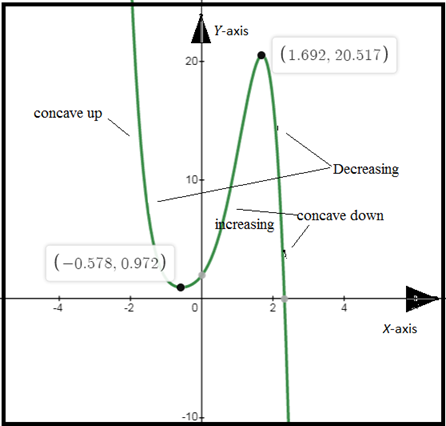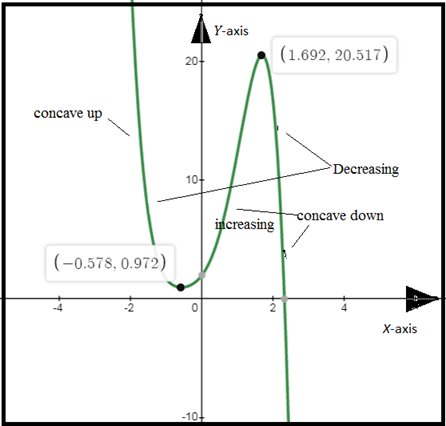
a.
Find the intervals on which the function is increasing using analytical method.
a.
Answer to Problem 14RE
Function
Explanation of Solution
Given:
Function
Concept used:
If the derivative of a function is positive on an interval, then the function is increasing on that interval.
Also, if the derivative of a function is negative on an interval, then the function is decreasing on that interval.
Calculation:
First derivative of
For solution put
Thus,
According to a known result
Thus,
So,
Conclusion:
Function
b.
Find the intervals on which the function is decreasing using analytical method.
b.
Answer to Problem 14RE
Function
Explanation of Solution
Given:
Function
From part (a), first derivative of
Concept used:
If the derivative of a function is positive on an interval, then the function is increasing on that interval.
Also, if the derivative of a function is negative on an interval, then the function is decreasing on that interval.
Calculation:
First derivative of
According to a known result
Thus,
So,
Conclusion:
Function
c.
Find the intervals on which the function is concave up using analytical method.
c.
Answer to Problem 14RE
Function
Explanation of Solution
Given:
Function
First derivative of
Concept used:
If the second derivative of a function is positive on an interval, then the function is concave up on that interval.
Also, if the second derivative of a function is negative on an interval, then the function is concave down on that interval.
Calculation:
First derivative of
Second derivative of
Differentiate the
For solution put
Since,
According to a known result
Thus,
So,
Conclusion:
Function
d.
To Find: the intervals on which the function is concave down using analytical method.
d.
Answer to Problem 14RE
Function
Explanation of Solution
Given:
Function
First derivative of
Second derivative of
Concept used:
If the second derivative of a function is positive on an interval, then the function is concave up on that interval.
Also, if the second derivative of a function is negative on an interval then the function is concave down on that interval.
Calculation:
Second derivative of
For solution put
Since,
According to a known result
Thus,
So,
Graph of function
:

Conclusion:
Function
e.
Find local extreme values using the graph.
e.
Answer to Problem 14RE
Function has
Function has
Explanation of Solution
Given:
Function
Graph of function

Calculation:
According to the graph,
Function has local
Function has local
Conclusion:
Function has local maxima at
Function has local minima at
f.
Find inflection points using the graph.
f.
Answer to Problem 14RE
Inflection point
Explanation of Solution
Given:
Function
Second derivative of
Concept used:
Inflection point: A point of inflection on a curve is a continuous point at which the function changes its concavity.
Calculation:
Second derivative of
For inflection point put
Inflection point:
Conclusion:
Inflection point is
Chapter 4 Solutions
Advanced Placement Calculus Graphical Numerical Algebraic Sixth Edition High School Binding Copyright 2020
- 6. [-/1 Points] DETAILS MY NOTES SESSCALCET2 6.5.001. ASK YOUR TEACHER PRACTICE ANOTHER Let I = 4 f(x) dx, where f is the function whose graph is shown. = √ ² F(x 12 4 y f 1 2 (a) Use the graph to find L2, R2 and M2. 42 = R₂ = M₂ = 1 x 3 4arrow_forwardpractice problem please help!arrow_forwardFind a parameterization for a circle of radius 4 with center (-4,-6,-3) in a plane parallel to the yz plane. Write your parameterization so the y component includes a positive cosine.arrow_forward
- ~ exp(10). A 3. Claim number per policy is modelled by Poisson(A) with A sample x of N = 100 policies presents an average = 4 claims per policy. (i) Compute an a priory estimate of numbers of claims per policy. [2 Marks] (ii) Determine the posterior distribution of A. Give your argument. [5 Marks] (iii) Compute an a posteriori estimate of numbers of claims per policy. [3 Marks]arrow_forward2. The size of a claim is modelled by F(a, λ) with a fixed a a maximum likelihood estimate of A given a sample x with a sample mean x = 11 = 121. Give [5 Marks]arrow_forwardRobbie Bearing Word Problems Angles name: Jocelyn date: 1/18 8K 2. A Delta airplane and an SouthWest airplane take off from an airport at the same time. The bearing from the airport to the Delta plane is 23° and the bearing to the SouthWest plane is 152°. Two hours later the Delta plane is 1,103 miles from the airport and the SouthWest plane is 1,156 miles from the airport. What is the distance between the two planes? What is the bearing from the Delta plane to the SouthWest plane? What is the bearing to the Delta plane from the SouthWest plane? Delta y SW Angles ThreeFourthsMe MATH 2arrow_forward
 Calculus: Early TranscendentalsCalculusISBN:9781285741550Author:James StewartPublisher:Cengage Learning
Calculus: Early TranscendentalsCalculusISBN:9781285741550Author:James StewartPublisher:Cengage Learning Thomas' Calculus (14th Edition)CalculusISBN:9780134438986Author:Joel R. Hass, Christopher E. Heil, Maurice D. WeirPublisher:PEARSON
Thomas' Calculus (14th Edition)CalculusISBN:9780134438986Author:Joel R. Hass, Christopher E. Heil, Maurice D. WeirPublisher:PEARSON Calculus: Early Transcendentals (3rd Edition)CalculusISBN:9780134763644Author:William L. Briggs, Lyle Cochran, Bernard Gillett, Eric SchulzPublisher:PEARSON
Calculus: Early Transcendentals (3rd Edition)CalculusISBN:9780134763644Author:William L. Briggs, Lyle Cochran, Bernard Gillett, Eric SchulzPublisher:PEARSON Calculus: Early TranscendentalsCalculusISBN:9781319050740Author:Jon Rogawski, Colin Adams, Robert FranzosaPublisher:W. H. Freeman
Calculus: Early TranscendentalsCalculusISBN:9781319050740Author:Jon Rogawski, Colin Adams, Robert FranzosaPublisher:W. H. Freeman
 Calculus: Early Transcendental FunctionsCalculusISBN:9781337552516Author:Ron Larson, Bruce H. EdwardsPublisher:Cengage Learning
Calculus: Early Transcendental FunctionsCalculusISBN:9781337552516Author:Ron Larson, Bruce H. EdwardsPublisher:Cengage Learning





